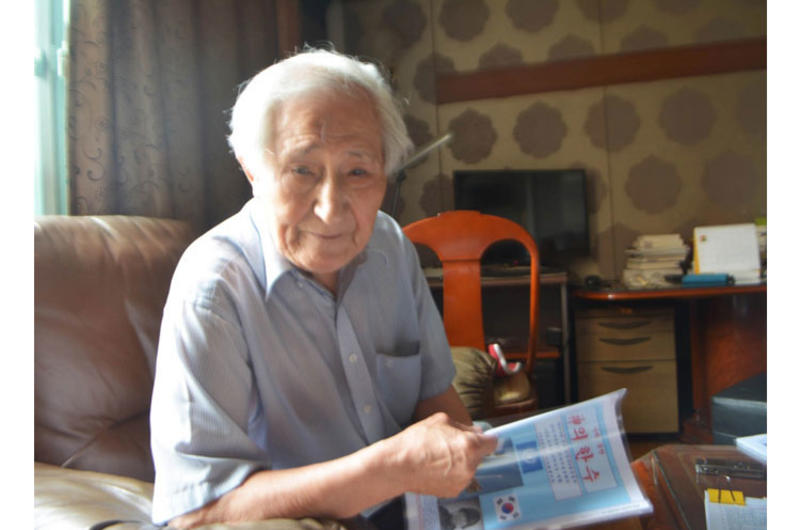

This website was created and maintained from May 2020 to May 2021 to commemorate the 75th anniversary of Stars and Stripes operations in the Pacific.
It will no longer be updated, but we encourage you to explore the site and view content we felt best illustrated Stars and Stripes' continued support of the Pacific theater since 1945.
Fighting to change history: Korean vet accused of treason says he saved his country

John Hong, an 86-year-old Korean veteran accused of treason and sentenced to death at the start of the 1950-53 war, has won a battle to clear his name. Now he is fighting to change history.
By KIM GAMEL | Stars and Stripes October 5, 2016
SEOUL, South Korea — An 86-year-old Korean veteran accused of treason and sentenced to death at the start of the Korean War has won a battle to clear his name. Now he is fighting to change history.
John Hong’s story began with the North Korean invasion of Seoul in June 1950. He was a cadet at the military academy in the city and ended up stranded on the wrong side of the Han River after the U.S.-backed government fled south, blowing up a strategic bridge behind them.
Hong has spent decades combing through history books and archives to collect the documents to prove he was a war hero, not a traitor.
“I saved my country,” said Hong, who lives in California and has dual citizenship. “They must give me something. They ruined my life.”
Fleeing the North
As North Korea occupied Seoul, Hong fled to the mountains and hid at a friend’s house. But the friend turned out to be a communist sympathizer who ominously warned the 19-year-old private to surrender to the North or join the volunteer Red Army if he wanted to survive.
Then known by his Korean name, Hong Yoon-hee, he joined the volunteer forces planning to make his way to the front lines, then sneak across to rejoin friendly forces. He used a fake ID claiming to be the brother of North Korean Vice Premier Hong Myung Hi, who he said was a distant relative.
Hong stepped up his plans after learning that North Korean leader Kim Il Sung had ordered an all-out assault in early September to break through the Pusan Perimeter, the allied forces’ defensive line around the southeastern tip of the peninsula.
“I was shocked, but then I decided I have to deliver this information to my country,” Hong told Stars and Stripes during a recent interview at a relative’s apartment in Seoul. “I have to save my country.”
He slipped away from his unit Aug. 31, 1950, walking overnight until he spotted U.N. troops and gave them his urgent news about the general offensive.
Still wearing the North Korean army uniform, he was interrogated for hours by an American intelligence officer.
But instead of being welcomed home as a hero, Hong was arrested a few days later and charged with espionage. He says he was tortured and sentenced to death, but an old friend served as his attorney and got the charges reduced.
Hong was released after five years and reunited with his family, who had been told he was dead. He got married and found work in a concrete factory. In 1973, he and his wife fled to the United States out of fear he might be rearrested under a new national security law.
Hong, who settled in Union City, Calif., initially didn’t question his past.
“I thought my report must have been wrong and there was no general offensive and that’s why they arrested me,” he said.
But one day in 1988, he read a book giving credit to a North Korean defector, Maj. Kim Song Jun for providing the tip and helping to turn the tide of the war. He was shocked to learn the official histories of the U.S. and South Korean militaries did the same.
“Then I said, ‘Oh my god. I thought that my report was false, but it was true,’” he said.
Proving his case
Hong began searching history books and archives. He returned to Korea and requested copies of his trial records and interrogation reports but was told they had been destroyed in a fire.
He appealed to South Korea’s Ministry of National Defense and U.S. Forces Korea, but nobody could find any trace of his case.
“They said the records were all burned out, but I never gave up,” he said, leafing through binders that hold copies of documents and articles about his case, painstakingly translated and annotated.
They include many showing that it was unlikely the North Korean defector was the source of the information.
For one thing, Kim had returned to the North in a prisoner exchange in 1953. Interrogation reports also noted that Kim had “heard a general offensive was to start. Details unknown,” and showed that the official histories had his date of surrender wrong.
Hong scoured thousands of other prisoner-of-war reports to make sure nobody else mentioned the crucial tip.
He also found his own court-martial records from 1950 and noticed they claimed he had fought South Koreans in a Sept. 3 battle, which could not have been true because Hong was already back on the other side by then.
Still, the clues didn’t add up to the convincing evidence he needed for a retrial.
The smoking gun
The breakthrough came in 2011, when he found a March 5, 1954, memo by a military historian, Lt. Col. Roy E. Appleman, in the archives of the National Institute of Korean History in Seoul.
Appleman wrote the U.S. Army’s official history of the first six months of the war, “South to the Naktong, North to the Yalu,” which describes Kim as tipping off U.N. forces about the offensive.


